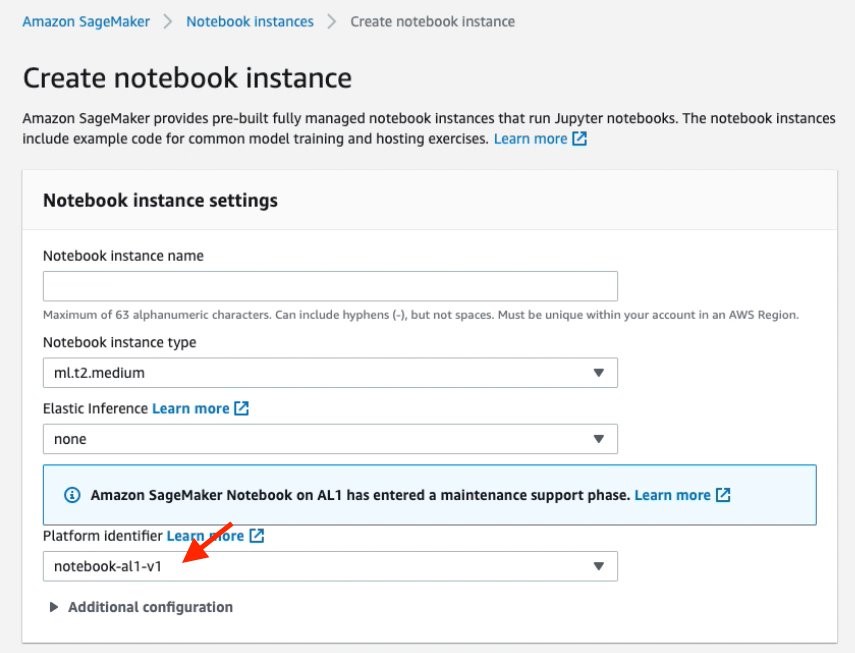Today, we’re excited to announce that Amazon SageMaker notebook instances support Amazon Linux 2. You can now choose Amazon Linux 2 for your new SageMaker notebook instance to take advantage of the latest update and support provided by Amazon Linux 2.
SageMaker notebook instances are fully managed Jupyter Notebooks with pre-configured development environments for data science and machine learning. Data scientists and developers can spin up SageMaker Notebooks to interactively explore, visualize and prepare data, and build and deploy models on SageMaker.
Introduced in 2017, Amazon Linux 2 is the next generation of Amazon Linux, a Linux server operating system from AWS first launched in September 2010. Amazon Linux 2 provides a secure, stable, and high-performance runtime environment to develop and run cloud and enterprise applications. With Amazon Linux 2, you get an environment that offers long-term support with access to the latest innovations in the Linux offering. AWS provides long-term security and maintenance updates for the Amazon Linux 2 AMI while the Amazon Linux AMI ended its standard support on December 31, 2020 and has entered a maintenance support phase.
In this post, we show you what your new experience with an Amazon Linux 2 based SageMaker notebook instance looks like. We also share the support plan for Amazon Linux based notebook instances. To learn how to migrate your work from an Amazon Linux based notebook instance to a new Amazon Linux 2 based notebook instance, see our next post Migrate your work to an Amazon SageMaker notebook instance with Amazon Linux 2.
What’s new with Amazon Linux 2 based notebook instances
For a data scientist using SageMaker notebook instances, the major difference is the notebook kernels available in the instance. Because Python 2 has been sunset since January 1, 2020, the kernels with Python 2.x are no longer available in the Amazon Linux 2 based notebook instance. You need to port your code and notebooks from Python 2 to Python 3 before using the same code with python3.x kernels.
Another set of kernels that are no longer provided within the Amazon Linux 2 based instance are Chainer kernels (conda_chainer_p27 and conda_chainer_p36). Chainer has been in a maintenance phase since December 5, 2019, when the last major upgrade to v7 was released. Chainer users are encouraged to follow the migration guide provided by Chainer to port the Chainer code into PyTorch and use the conda_pytorch_p36 or conda_pytorch_latest_p37 in the notebook instance.
SageMaker notebook instances use AMIs that are built on top of the AWS Deep Learning AMI. Therefore, you can find detailed release notes and differences in the AWS Deep Learning AMI (Amazon Linux) and AWS Deep Learning AMI (Amazon Linux 2).
The Amazon Linux 2 option in SageMaker notebook instances is now available in AWS Regions in which SageMaker notebook instances are available.
Support plan for Amazon Linux on SageMaker notebook instances
On August 18, 2021, we’re rolling out the Amazon Linux 2 AMI option for users on SageMaker notebook instances. You have the option to launch a notebook instance with the Amazon Linux 2 AMI while the Amazon Linux AMI remains as the default during the setup.
Your existing notebook instances launched before August 18, 2021 will continue to run with Amazon Linux AMI. All notebook instances with either the Amazon Linux AMI or Amazon Linux 2 AMI will continue to receive version updates and security patches when instances are restarted.
On April 18, 2022, the default AMI option when creating a new notebook instance will switch to the Amazon Linux 2 AMI, but we’ll still keep the Amazon Linux AMI as an option. A new notebook instance with the Amazon Linux AMI will use the last snapshot of the Amazon Linux AMI created on April 18, 2022 and will no longer receive any version updates and security patches when restarted. An existing notebook instance with the Amazon Linux AMI, when restarted, will receive a one-time update to the last snapshot of the Amazon Linux AMI created on April 18, 2022 and will no longer receive any version updates and security patches afterwards.
Set up an Amazon Linux 2 based SageMaker notebook instance
You can set up a SageMaker notebook instance with the Amazon Linux 2 AMI using the SageMaker console (see Create a Notebook Instance) or the AWS Command Line Interface (AWS CLI).
When using the SageMaker console, you have a new option, Platform identifier, to choose the Amazon Linux AMI version. notebook-al2-v1 refers to the Amazon Linux 2 AMI, and notebook-al1-v1 refers to the Amazon Linux AMI. As described in the previous section, the default is notebook-al1-v1 until April 18, 2022, and will switch to notebook-al2-v1 on April 18, 2022.
If you prefer to create a notebook instance with the AWS CLI, you can use the new argument platform-identifier to indicate the choice for the Amazon Linux AMI version. Similarly, notebook-al2-v1 refers to the Amazon Linux 2 AMI, and notebook-al1-v1 refers to the Amazon Linux AMI. For example, a command to create an instance with the Amazon Linux 2 AMI looks like the following command:
aws sagemaker create-notebook-instance
--region region
--notebook-instance-name instance-name
--instance-type ml.t3.medium
--role-arn sagemaker-execution-role-arn
--platform-identifier notebook-al2-v1 Next steps
If you want to move your existing work to a new notebook instance, see our next post, Migrate your work to an Amazon SageMaker notebook instance with Amazon Linux 2. You can learn how to migrate your work and data on an existing notebook instance to a new, Amazon Linux 2 based instance.
Conclusion
Today, we announced SageMaker notebook instance support for the Amazon Linux 2 AMI and showed you how to create a notebook instance with the Amazon Linux 2 AMI. We also showed you the major differences for developers when using an Amazon Linux 2 based notebook instance. You can start your new ML development on an Amazon Linux 2 based notebook instance or try out Amazon SageMaker Studio, the first integrated development environment (IDE) for ML.
If you have any questions and feedback regarding Amazon Linux 2, please speak to your AWS support contact or post a message in the Amazon Linux Discussion Forum and SageMaker Discussion Forum.
About the Authors
 Michael Hsieh is a Senior AI/ML Specialist Solutions Architect. He works with customers to advance their ML journey with a combination of Amazon Machine Learning offerings and his ML domain knowledge. As a Seattle transplant, he loves exploring the great nature the region has to offer, such as the hiking trails, scenery kayaking in the SLU, and the sunset at the Shilshole Bay.
Michael Hsieh is a Senior AI/ML Specialist Solutions Architect. He works with customers to advance their ML journey with a combination of Amazon Machine Learning offerings and his ML domain knowledge. As a Seattle transplant, he loves exploring the great nature the region has to offer, such as the hiking trails, scenery kayaking in the SLU, and the sunset at the Shilshole Bay.
 Sam Liu is a Product Manager at Amazon Web Services (AWS) focusing on AI/ML infrastructure and tooling. Beyond that, he has 10 years of experience building machine learning applications in various industries. In his spare time, he enjoys golf and international traveling.
Sam Liu is a Product Manager at Amazon Web Services (AWS) focusing on AI/ML infrastructure and tooling. Beyond that, he has 10 years of experience building machine learning applications in various industries. In his spare time, he enjoys golf and international traveling.
 Jun Lyu is a Software Engineer on the SageMaker Notebooks team. He has a Master’s degree in engineering from Duke University. He has been working for Amazon since 2015 and has contributed to AWS services like Amazon Machine Learning, Amazon SageMaker Notebooks, and Amazon SageMaker Studio. In his spare time, he enjoys spending time with his family, reading, cooking, and playing video games.
Jun Lyu is a Software Engineer on the SageMaker Notebooks team. He has a Master’s degree in engineering from Duke University. He has been working for Amazon since 2015 and has contributed to AWS services like Amazon Machine Learning, Amazon SageMaker Notebooks, and Amazon SageMaker Studio. In his spare time, he enjoys spending time with his family, reading, cooking, and playing video games.

